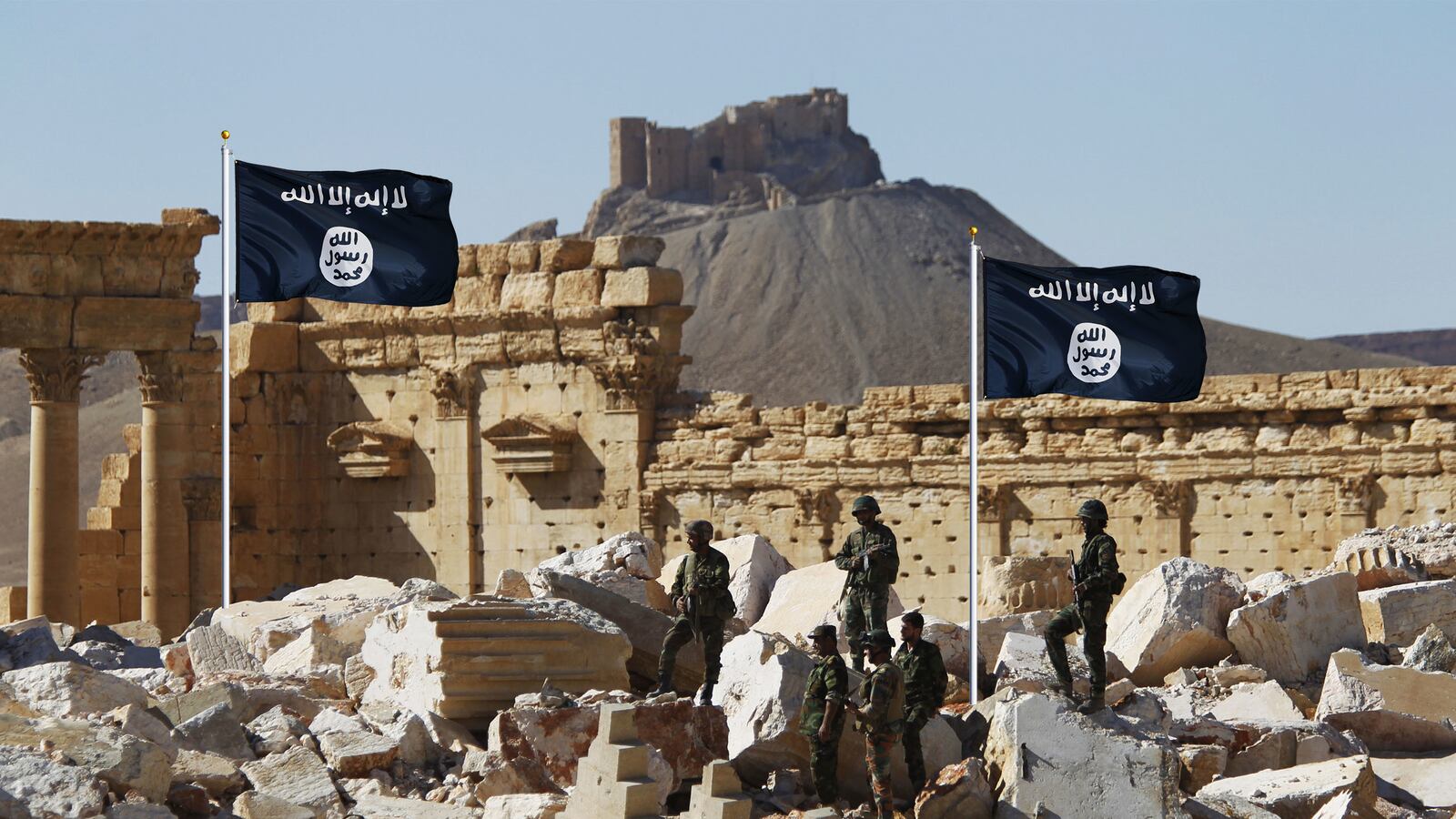“Our future Russian allies, with all their international legitimacy, are too busy elsewhere in Syria to help much against ISIS.”
So witheringly tweeted former U.S. ambassador Robert Ford on the day that the CIA went public with disclosures about Russian government hacks designed to get Donald Trump elected president; a report emerged that Trump’s imminent appointment for Secretary of State is ExxonMobil CEO Rex W. Tillerson, a personal friend of Vladimir Putin who awarded him Russia’s Order of Friendship in 2012; and news broke that ISIS has recaptured much of the ancient Syrian city of Palmyra, its most successful territorial revanche in two years.
Moscow, as Ford implied, was evidently too busy bombing the rebel-held parts of Eastern Aleppo to prevent one of its major symbolic prizes in the war in Syria from slipping its grasp.
The crossroads of several antique civilizations, Palmyra was sacked by the head-chopping fanatics of the so-called Islamic State in May 2015, just days after they seized the Iraqi provincial capital of Ramadi. After promising not to powder the standing Roman, Persian and Assyrian ruins which have made the city a UNESCO World Heritage Site, ISIS did indeed blow up millennia-old monuments, horrifying historians and archaeologists.
Palmyra’s recapture last March by Syrian government loyalists, backed by heavy Russian airstrikes and Russian-seconded ground mercenaries — including veterans of the 1990s Balkans wars — was met with cheers from some Western officials, such as then-British MP and now British Foreign Secretary Boris Johnson, as a triumph of culture over barbarism.
Which was exactly the intended propaganda point being made by the Kremlin.
To certify its role as a preeminent counterterrorist, Russia hosted an international concert and press junket in the craggy Roman amphitheater in May. Renditions of Bach and Prokofiev were performed by the Mariinsky Symphony Orchestra conducted by Valery Gergiev, a staunch defender of Putin, and cellist Sergei Roldugin, a man who had been named in the Panama Papers disclosures as the Russian president’s personal bagman for maintaining hundreds of millions of dollars in offshore investments.
Putin initially maintained, in a speech at the United National General Assembly in September 2015, that his direct military intervention in Syria’s conflict was being waged to stop ISIS. Both U.S. government and independent analyses have shown that this was a falsehood; the majority of Russian aerial sorties have been waged against non-ISIS targets, including and especially CIA-backed Free Syrian Army units.
However, in last year, the Russian Foreign Affairs and Defense Ministry have steadily and moved the goal posts of their casus belli, characterizing any and all armed opponents of the Assad regime as “terrorists” worthy of killing, or trying to steal them away from being proxies of the Untied States.
So far, over the course of a 72-hour blitzkrieg, ISIS has retaken the strategic mountain perches of Jabal al Tar and Jabal Antara, overlooking Palmyra, as well as the northeastern and western neighborhoods, all of the oil and gas fields northwest of the city, a military warehouse and another military installation. The terror army entered the city center on Saturday, where it continues to clash with those remaining regime forces. It may have also downed a Syrian MiG-23 fighter jet, according to their Amaq News Agency, although this information has yet to be confirmed.
Khaled al-Homsi, an archaeologist from Palmyra who now lives in Turkey but keeps in contact with both opposition and regime sources, estimates that about 50 percent of the city has fallen to ISIS. The Assadists still control Tadmor airport, a military intelligence headquarters and Tadmor Palace.
“It was exactly the same strategy as Daesh used last time,” al-Homsi told The Daily Beast, using the pejorative Arabic acronym for ISIS.
He said that a mere 50 to 60 jihadists were currently besieging Palmyra, which now contains as many civilians but around 1,000 Syrian army personnel and between 1,500 and 2,000 pro-Assad militiamen.
Russian officers stationed at Palmyra, he said, withdrew four days ago; they were then followed by leadership of Assad’s regular army and his militias a day later. All quit the scene because they saw how quickly the few dozen ISIS militants were advancing in their direction, according to al-Homsi.
A pro-regime source told The Daily Beast that the oil and gas fields were defended by the National Defense Force, a pro-Assad militia built and trained by Iran. "The NDF had over 800 men posted around the straetgic Shaar gas field and the other areas, in addition to around 250 regular soldiers, the source said. "They had maintained defensive positions for the last 6 months. In August, operations had been stopped. When ISIS attacked days ago they retreated and left most of the heavy weapons without a fight. In the panic, over 100 were killed or are still missing. Word is that a senior NDF commander who was stationed around Shaar was bribed by ISIS. It is not the first time this has happened. A decision was made to prevent the city falling at all costs."
The Daily Beast could not independently verify these claims. The London-based Syrian Observatory for Human Rights (SOHR) puts the number of jihadist attackers at 200.
But al-Homsi maintained that such a disparity in an order of battle was nothing new for Syria, or for Palmyra. “It’s exactly the same as what happened last time [in May 2015] when there were even more than three thousand pro-regime forces. Most of them just deserted, then as now.”
Having been caught off guard, the Assad coalition has been scrambling to counterattack. The SOHR reported today that warplanes and helicopters “continue the intensified bombardment” on areas now held by ISIS. The regime is also firing missiles on these locations and sending reinforcements.
But it remains unclear how soldiers the regime can field the attack given its more concerted effort to seize and hold all of Eastern Aleppo, where ISIS is nonexistent but a consortium of anti-Assad rebels, including those in the al-Qaeda affiliate Jabhat Fateh al-Sham, are retreating in rapid fashion.
Analysts such as Middle East Institute fellow Charles Lister and researchers at the Washington, D.C.-based Syrian Institute estimate that Assad’s only got about 20,000 reliable regular army soldiers nationwide. Over two-thirds of his hodgepodge coalition consists of sectarian militias of various nationalities led by warlords and trained up by Iran’s Revolutionary Guards Corps, if not “advised” by Russian commandos. Lebanese, Iraqi, Pakistan and Afghan Shiite jihadists are known to do the heavy lifting on behalf of Damascus.
ISIS appears set on marching on the T4 airbase, Syria’s largest, where the regime keeps two fixed-wing attack squadrons, of Su-24 and of Su-22 fighter jets, as well as a fleet of helicopter gunships.
Following its intervention, in late September 2015, Russia has also kept a contingent of warplanes and helicopters there. In May 2016, three months after ISIS was driven from Palmyra, the group waged an opportunistic attack on the base, damaging or destroying at least one MiG-25 Foxbat attack jet and four Mi-24 Hind helicopters, according to satellite footage obtained by the intelligence firm Stratfor.
--With additional reporting by Hassan Hassan






